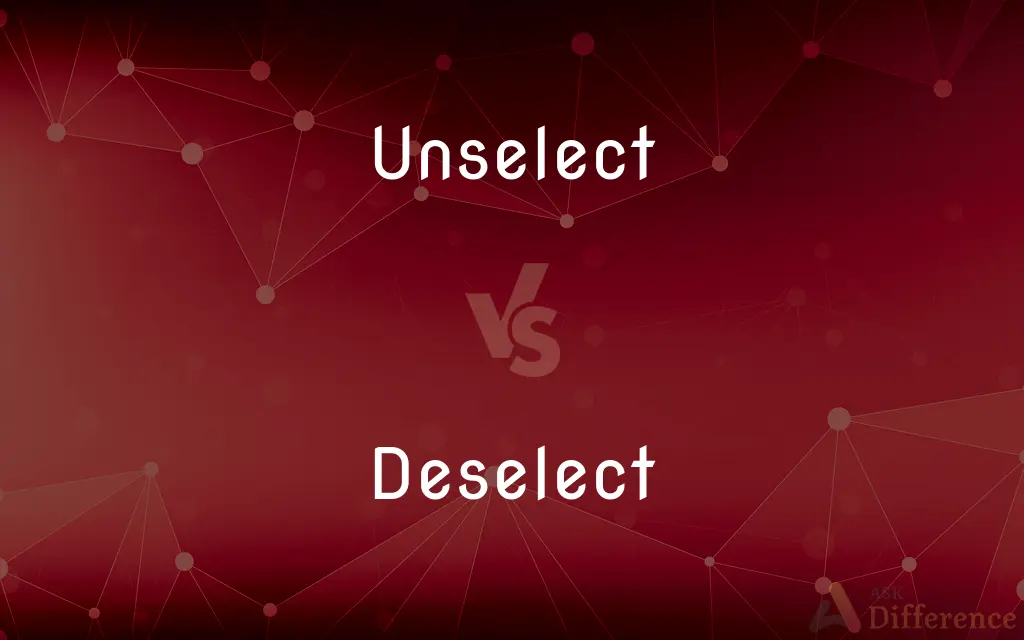Unselect vs. Deselect — What's the Difference?
By Urooj Arif & Fiza Rafique — Updated on February 24, 2024
"Unselect" implies reversing the action of choosing or highlighting, often used informally. "Deselect" specifically means to remove the selection from an item, commonly used in technical and user interface contexts.

Difference Between Unselect and Deselect
Table of Contents
ADVERTISEMENT
Key Differences
"Unselect" is a less formal term that suggests the act of undoing a selection, not strongly tied to technical contexts. It's understood in everyday language but is less common in official documentation or software interfaces. "Deselect," on the other hand, is the preferred term in computing and digital environments, clearly indicating the action of removing a previously made selection, such as unticking a checkbox or clicking away from a highlighted item.
The usage of "unselect" can be found in casual conversations or instructions, where the context does not demand strict technical language. It conveys the idea of reversing a choice or preference without specifying the means. In contrast, "deselect" is often accompanied by specific instructions or guidelines in user interfaces, ensuring clarity in actions that users need to take to remove their choices or highlights.
In user experience (UX) design and software documentation, "deselect" is favored for its precision and clarity, aligning with the terminology used in most operating systems and applications. This term helps maintain consistency across platforms, reducing confusion for users. "Unselect" might be used in general discussions or when the action of removing a selection is implied rather than explicitly instructed.
The choice between "unselect" and "deselect" can also reflect the formality and specificity of the context. Informal settings or broader discussions about selection processes might lean towards "unselect," while technical manuals, software applications, and professional contexts would typically use "deselect."
Comparison Chart
Formality
Informal
Formal, technical
ADVERTISEMENT
Common Usage
General conversation, non-technical contexts
Computing, user interfaces, technical documentation
Implication
Broad, implying the reversal of a selection
Specific, indicating the removal of a selection
User Experience
Less common in UX design
Widely used in UX design for clarity and consistency
Contextual Preference
Preferred in casual or non-specific discussions
Preferred in specific instructions and technical settings
Compare with Definitions
Unselect
Not typically used in technical documentation.
The guide mentioned how to unselect an item, which seemed informal.
Deselect
Common in computing and user interfaces.
The software allows you to easily deselect options.
Unselect
Conveys a general idea of removing a choice.
Unselect all items that do not apply to your situation.
Deselect
Associated with specific user actions.
To modify your selection, first deselect the current option.
Unselect
Informally implies reversing a selection.
You can unselect those options if you change your mind.
Deselect
Ensures clarity in digital environments.
Hover over the item and click to deselect it.
Unselect
Often used in everyday language.
Just unselect your previous choice and proceed.
Deselect
Preferred in technical and professional contexts.
The manual clearly states how to deselect items.
Unselect
Less precise than deselect.
The instructions said to unselect, but it wasn't clear how.
Deselect
Formally used to indicate removing a selection.
Deselect the checkbox if you wish to opt out.
Unselect
To cancel a previous selection, especially by removing a mark from a tick box.
Deselect
To reject (an incumbent) as a party's candidate for a forthcoming election.
Unselect
(transitive) To reverse the previous selection of. en
Deselect
(transitive) To not select; to rule out of selection.
Deselect
To remove from an existing selection.
Make sure you deselect any files you wish to keep before proceeding with the deletion.
Common Curiosities
What is the difference between deselecting and unselecting in a user interface?
In a user interface, "deselecting" specifically refers to the action of removing a selection, while "unselecting" is less commonly used and less formal.
What does it mean to unselect something?
To unselect something means to reverse or undo the action of choosing or highlighting it, often used informally.
Can I use "unselect" in an email explaining how to use a digital tool?
While understandable, using "deselect" in such emails would be more appropriate and professional, especially for clarity.
Is "deselect" the correct term to use in software applications?
Yes, "deselect" is the preferred term in software applications and technical contexts for its clarity and specificity.
Can "unselect" be used in formal documents?
While understandable, "unselect" is less formal and less common in official documentation, where "deselect" is preferred.
How do I instruct someone to remove their selection in a technical manual?
In a technical manual, it's best to use "deselect" to instruct someone to remove their selection for precision and clarity.
Why is consistency important in using terms like "unselect" and "deselect"?
Consistency in using terms like "deselect" in technical contexts helps avoid confusion and ensures clear communication, especially in instructions and user interfaces.
Is there a scenario where "unselect" is preferred over "deselect"?
"Unselect" might be preferred in informal discussions or when the context doesn't require the specificity of "deselect."
Is "unselect" a real word?
"Unselect" is understood and used in everyday language but is less formal and not as widely accepted in technical contexts as "deselect."
Can "deselect" be used in non-technical language?
While "deselect" can be used in non-technical language, it's more commonly and appropriately used in technical and digital contexts.
What term should I use in a user guide for a website?
In a user guide for a website, it's advisable to use "deselect" to describe removing selections for clarity and professionalism.
How does the choice between "unselect" and "deselect" affect user comprehension?
Using "deselect" in user interfaces and technical documents can enhance comprehension by providing clear, specific instructions.
Why might someone choose to use "unselect" despite "deselect" being more standard?
Someone might choose "unselect" for its casual tone or in less formal communication, where the distinction isn't critical.
How do UX designers decide between using "unselect" or "deselect"?
UX designers typically choose "deselect" for its precision and consistency with common software terminology, enhancing user understanding.
What impact does the informal use of "unselect" have in professional settings?
The informal use of "unselect" in professional settings might lead to ambiguity or appear less polished compared to using "deselect."
Share Your Discovery

Previous Comparison
Plagiarism vs. Plagiary
Next Comparison
Scantily vs. ScantlyAuthor Spotlight
Written by
Urooj ArifUrooj is a skilled content writer at Ask Difference, known for her exceptional ability to simplify complex topics into engaging and informative content. With a passion for research and a flair for clear, concise writing, she consistently delivers articles that resonate with our diverse audience.
Co-written by
Fiza RafiqueFiza Rafique is a skilled content writer at AskDifference.com, where she meticulously refines and enhances written pieces. Drawing from her vast editorial expertise, Fiza ensures clarity, accuracy, and precision in every article. Passionate about language, she continually seeks to elevate the quality of content for readers worldwide.














































